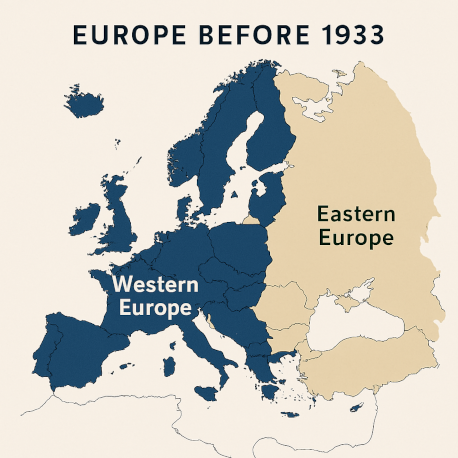The divide between Western Europe and Eastern Europe before 1933 was stark—politically, culturally, economically, and socially. Here’s a comparative breakdown to highlight the key differences:
🏛️ Political Systems
| Region | Dominant Political Structures (pre-1933) |
|---|---|
| Western Europe | Mostly liberal democracies or constitutional monarchies (e.g. UK, France, Belgium) |
| Eastern Europe | More authoritarian regimes, monarchies, or nascent democracies (e.g. Poland, Romania, Hungary) |
Eastern Europe was hit harder by the Great Depression, exacerbating antisemitism and social unrest.
Western economies, while strained, had more institutional resilience.
🧭 Geopolitical Identity
Western Europe was seen as the heart of Enlightenment values, liberalism, and modernity. Germany pre 1933 was seen as a centre of such European values.
Eastern Europe was often viewed as a frontier of empires—Austro-Hungarian, Russian, Ottoman—where ethnic tensions and nationalist movements simmered.
🕍 Jewish Population Distribution (1933)
| Country | Estimated Jewish Population (1933) |
|---|---|
| Poland | 3,000,000 |
| Soviet Union | 2,525,000 |
| Romania | 980,000 |
| Germany | 565,000 |
| Hungary | 725,000 with extended borders 1941 |
| France | 320,00 |
| United Kingdom | 300,000 |
Most Jews lived in Eastern Europe, comprising over half of Europe’s Jewish population.

So it should be noted that the known Jewish population of Germany was a small percentage of the entire population and a considerable number had intermarried and so had non-Jewish partners,
It might also be thought Jews might have had a higher rate of surviving Nazi round up after the conquest of France, Holland and Belgium. But the Nazis successfully exploited existing prejudices and in that era some countries like Holland and extensive records of peoples religious identities.
With this background hostility to Jews always present in countries like France and Holland Jews were easily identified and many were deported for extermination or if they were fit enough to factories for slave labour.
To rescue and hide Jews in Western Europe was just a brave act as in Eastern Europe except perhaps that Jews dress and speak the same language.
But in Eastern Europe the situation was very different.
Consider Hungary
Jewish Population in Hungary (Pre-1939)
- 1930 Census: Approximately 444,567 Jews lived within the borders of post-Trianon Hungary.
- 1941 Census: After territorial expansions (e.g. annexations from Yugoslavia), the Jewish population rose to 725,007, including 184,453 in Budapest alone.
🕍 Cultural and Social Context
- Hungary’s Jewish community was diverse:
- Neolog Jews: Modernized, often assimilated, urban professionals.
- Orthodox Jews: More traditional, especially in rural areas.
- Status Quo Ante: A smaller group that rejected both Neolog and Orthodox divisions.
- Jews played a major role in commerce, education, and the arts, especially in Budapest, where they made up nearly one-quarter of the population by 1910.
🇵🇱 Jewish Population of Poland (Pre-1933)
- Estimated Total: Around 3 million Jews lived in Poland by the early 1930s.
- Percentage of National Population: Jews made up roughly 10% of Poland’s total population.
- Urban Centers:
- Warsaw: Over 350,000 Jews, making it the largest Jewish city in Europe at the time.
- Łódź: Over 200,000 Jews.
- Lwów (now Lviv): Around 100,000 Jews.
- Kraków and Vilnius: Each had over 50,000 Jewish residents.
Cultural and Religious Life
- Poland’s Jewish community was incredibly diverse:
- Yiddish-speaking majority, with vibrant Hasidic and Orthodox traditions.
- Zionist movements, secular Jewish schools, and socialist organizations flourished.
- A rich tradition of Jewish literature, theater, and press.
- Poland was considered the spiritual and intellectual heart of European Jewry, with institutions like the Yeshiva of Lublin and the Bund (Jewish socialist party) playing major roles.
🇷🇴 Jewish Population of Romania (Pre-1933)
| Region | Jewish Population (1930) |
|---|---|
| Old Kingdom | 263,192 |
| Transylvania | 193,000 |
| Bessarabia | 206,958 |
| Bukovina | 92,988 |
| Total (Greater Romania) | 756,000 |
Source: YIVO Encyclopedia
🕍 Cultural and Social Context
- Jews made up about 4% of Romania’s total population in 1930.
- The community was linguistically and culturally diverse, including:
- Yiddish-speaking Ashkenazim in Moldavia and Bessarabia.
- Hungarian-speaking Jews in Transylvania.
- German-speaking Jews in Bukovina.
- Sephardic Jews in smaller numbers, especially in Dobruja.
- Romanian Jews were active in commerce, crafts, publishing, and education, though they faced increasing antisemitism and legal discrimination, especially during the interwar period.
Jewish Population of Ukraine (Pre-1933)
- Estimated Total: Approximately 1.5 to 1.6 million Jews lived in Ukraine in the early 1930s.
- This represented a significant portion of the 5.5 million Jews living in the USSR and Poland combined.
- Major Cities with Large Jewish Populations:
- Kyiv (Kiev): Tens of thousands of Jews, with vibrant cultural and religious life.
- Odessa: A major Jewish cultural hub, with over 150,000 Jews by the 1920s.
- Dnipro (then Yekaterinoslav), Kharkiv, and Lviv also had substantial Jewish communities.
🕍 Cultural and Political Context
- Jews in Ukraine were deeply involved in:
- Yiddish literature and theater, especially in Odessa and Kyiv.
- Zionist and socialist movements, including the Bund and Poale Zion.
- Religious life, with Hasidic dynasties and Orthodox communities thriving in western regions.
Jewish Population of Albania (Pre-1933)
- 1930 Census: Only 204 Jews were officially registered in Albania.
- By 1937, the community had grown slightly to around 300 members, and the Albanian government formally recognized the Jewish community.
🕍 Historical and Cultural Notes
- Most Albanian Jews were Sephardic, descended from Jews expelled from Spain and Portugal in the late 15th century.
- Jewish communities historically existed in cities like Vlorë, Berat, Elbasan, and Durrës.
- Despite its small size, Albania became a remarkable haven during WWII, famously increasing its Jewish population to nearly 2,000 by the war’s end due to its tradition of Besa—a cultural code of honor that protected refugees.
Post World War Two:
Poland:By 1946, the Jewish population of Poland had been devastated by the Holocaust, with only a small fraction of the pre-war community surviving.
Jewish Population of Poland in 1946
- Estimated Total: Around 240,000 to 250,000 Jews remained in Poland by mid-1946.
- This was a dramatic decline from the 3.4 million Jews living in Poland before WWII.
📉 Postwar Exodus and Violence
- Following the Kielce pogrom on July 4, 1946, anti-Jewish violence triggered mass emigration:
- ~20,000 Jews fled in July 1946
- ~30,000 in August
- ~12,000 in September
- By the end of 1946, over 120,000 Jews had left Poland, many heading westward toward displaced persons camps or emigrating to Palestine and the Americas.
🇭🇺 Jewish Population of Hungary in 1946
- Estimated Total: Approximately 140,000 Jews remained in Hungary after World War II.
- This was a sharp decline from the 725,000 Jews recorded in 1941.
- Of the wartime Jewish population, over 500,000 were murdered, including 260,000 from interwar Hungary alone.
📉 Postwar Trends
- Many survivors returned from concentration camps or hiding, but faced economic hardship and lingering antisemitism.
- Between 1945 and 1949, around 40,000–50,000 Jews emigrated, mostly to Israel and Western countries.
🇭🇺 Jewish Population of Hungary in 1946
- Estimated Total: Approximately 140,000 Jews remained in Hungary after World War II.
- This was a sharp decline from the 725,000 Jews recorded in 1941.
- Of the wartime Jewish population, over 500,000 were murdered, including 260,000 from interwar Hungary alone.
📉 Postwar Trends
- Many survivors returned from concentration camps or hiding, but faced economic hardship and lingering antisemitism.
- Between 1945 and 1949, around 40,000–50,000 Jews emigrated, mostly to Israel and Western countries.
Jewish Population of Ukraine in 1946
- Estimated Total: Approximately 500,000 to 600,000 Jews remained in Ukraine after World War II.
- This was a steep decline from the 1.5 to 1.6 million Jews who lived in Ukraine before the war.
- Over 1 million Ukrainian Jews were murdered during the Holocaust, many in mass shootings by Einsatzgruppen and local collaborators.
📉 Postwar Realities
- Survivors included:
- Those who had fled eastward into the Soviet interior.
- Those who returned from camps or hiding.
- Many faced antisemitism, property loss, and Soviet repression, including the suppression of Jewish religious and cultural life.
- Emigration was limited due to Soviet restrictions, but some Jews managed to leave for Poland, Romania, or displaced persons camps in Western Europe.
In 1946, Albania had a Jewish population of approximately 2,000—a remarkable increase from the mere 200–300 Jews living there before World War II.
Why the Increase?
Albania was unique among Nazi-occupied countries in Europe for having more Jews after the war than before. This was due to:
Jewish refugees from Germany, Austria, Yugoslavia, and Greece found safety in Albania during the war2.
Besa, a traditional Albanian code of honor and hospitality, which compelled locals to protect refugees.
Widespread sheltering of Jews by both Muslim and Christian Albanians.
Refusal to comply with Nazi demands for deportation lists.
In 1946, the Jewish population of France was estimated at approximately 180,000 individuals:
Jewish Population of France in 1946
- 160,000 were prewar residents who had survived the Holocaust.
- ~20,000 were refugees from Central and Eastern Europe who had fled to France after the war.
- France thus became the second-largest Jewish community in continental Europe after Romania.
📉 Context and Recovery
- Before WWII, France had about 350,000 Jews, including many refugees from Germany, Poland, and Austria.
- Roughly 75,000 Jews were deported from France during the Holocaust; only about 2,500 survived.
- Postwar Jewish life in France was marked by:
- Rebuilding communities and institutions.
- Restoring property and caring for orphans and displaced persons.
- A growing influx of Jewish refugees and survivors, especially from DP camps.
In 1946, the Jewish population of the Netherlands (Holland) was estimated at approximately 30,000 to 35,000 individuals.
Jewish Population of the Netherlands in 1946
- Prewar Population (1939): Around 140,000 to 150,000 Jews, including 24,000–34,000 refugees from Germany and other Nazi-controlled areas.
- Holocaust Impact: About 75% of Dutch Jews—roughly 105,000—were murdered during the Holocaust, primarily in Auschwitz and Sobibor.
- Postwar Survivors: By 1946, only 30,000 to 35,000 Jews remained, including:
- Survivors of concentration camps.
- Those who had gone into hiding.
- A small number of returning refugees.
📉 Postwar Challenges
- Many survivors faced trauma, loss of family, and property confiscation.
- Jewish communal life had to be rebuilt from near-total destruction.
- Emigration to Israel, the United States, and other countries accelerated in the late 1940s.
Jewish Population of Germany in 1946
| Region | Estimated Jewish Population (1946) |
|---|---|
| Western Germany (U.S., British, French zones) | ~150,000 Jews |
| Eastern Germany (Soviet zone) | ~3,000 to 5,000 Jews |
📍 Context and Notes
- Western Germany:
- Included large numbers of Jewish DPs in camps administered by the Allies.
- Many survivors from Poland, Hungary, and other Eastern European countries were temporarily housed here.
- Jewish life began to slowly rebuild, especially in cities like Frankfurt, Munich, and Berlin (Western sector).
- Eastern Germany:
- Jewish population was minimal due to:
- Soviet restrictions on religious and communal life.
- Emigration to the West or Palestine.
- Fear of renewed antisemitism and repression.
- Jewish population was minimal due to:

